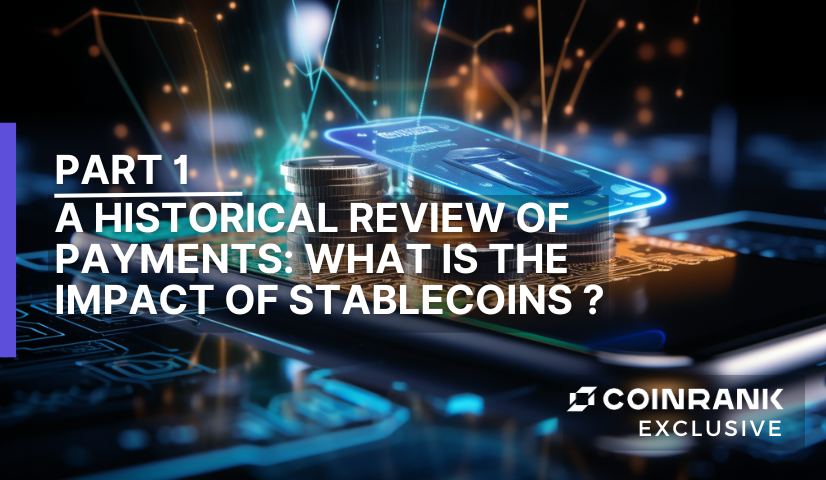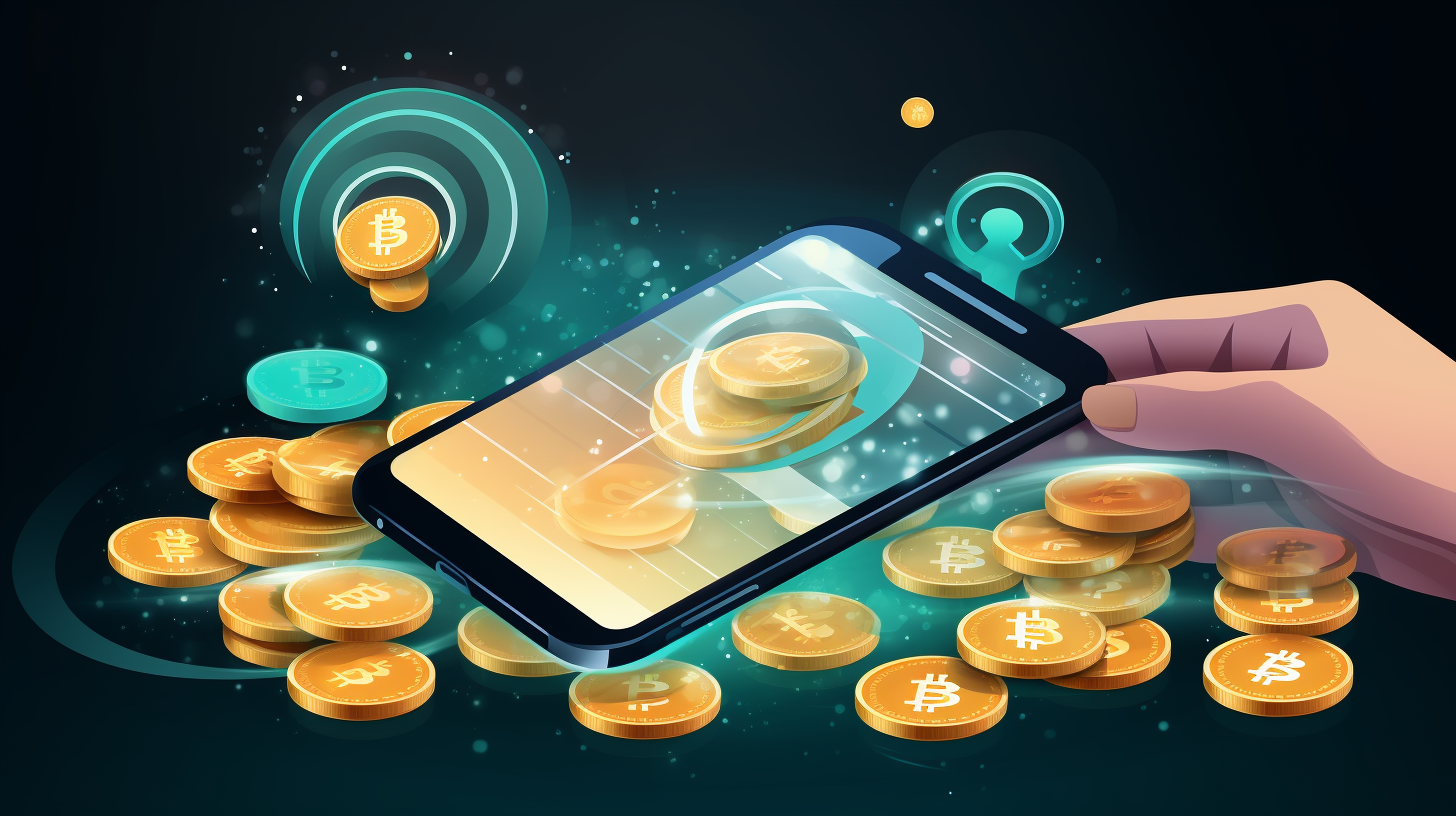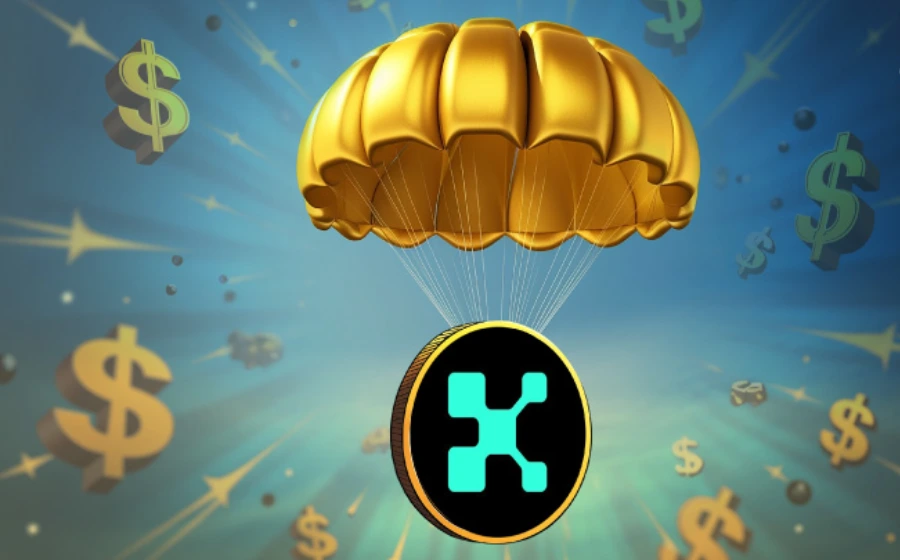
KEYTAKEAWAYS
- Payment Evolution: Payments have transformed from cash to complex digital systems driven by technology.
- Banks and Tech: Banks have facilitated cross-border transactions, while tech has improved e-commerce and remittances.
- Stablecoins and Blockchain: Stablecoins on blockchain enable rapid cross-border transfers, showcasing blockchain's transformative potential, not just in payments but in areas like the metaverse.

CONTENT
INTRODUCTION
*This article was originally published in Chinese and on the Blog- Code and law.
When we talk about payments, what comes to your mind? Cash transactions, check payments, credit cards, or QR code scanning? Indeed, these are all common payment scenarios we encounter, where the process seems merely like exchanging money for goods. However, this seemingly straightforward act has evolved in response to changes in our societal activities. Today, it has developed into a vast and complex system, evolving into various service providers that support our daily payment activities. If these service providers face issues or if there are failures in their information systems, it could lead to catastrophic impacts on our lives, extending beyond mere inconveniences like not being able to buy a coffee.

WHAT IS THE ESSENCE OF PAYMENT?
To explain the concept of payment in the simplest terms: Imagine you’re buying something at a convenience store. The store gives you a cup of coffee, and you pay for it. This is our most direct understanding of payment: ‘ handing over money and receiving goods at the same time.’
However, not every transaction allows for such an immediate exchange. Sometimes goods or services are provided first, followed by payment, or vice versa. This type of transaction is common in cross-regional and international trade. For example, in international import and export, services or goods must be delivered before payment is made. Here, the concept of payment can be described as: ‘In a transaction, the seller provides goods or services to the buyer, and the buyer gives a certain monetary value to the seller, completing the transaction.’ This definition includes the concept of exchanging money for goods directly.
Beyond these examples, if we consider payments like contractually agreed-on donations to charities or tax payments to governments, which are not typically in exchange for specific goods or services but to fulfill legal obligations. In this context, the concept of payment becomes ‘a process of value transfer that ends a legal obligation with a monetary transaction, explained from the legal perspective.’
From the analysis above, we can grasp the core concept of payment, which is basically the transfer of monetary value to conclude a relationship or transaction between individuals or legal entities. Examined from the standpoint of human ‘activity’, we may gain a more intuitive understanding of payment. For instance, we might see direct transactions (exchanging money for goods) as the most ideal way because the payment occurs instantaneously. However, in cross-regional or international deals, the dynamics change. For example, when a seller ships goods to the USA, the buyer may not be able to pay in dollars immediately, or they might be unsure if the seller will provide the goods after receiving the payment. In such situations, either party must wait to confirm the receipt of money or goods before the transaction can be considered complete. Any mistakes (like not receiving the goods or the payment) make it difficult to conclude the relationship.
This is where the ‘third party’ concept emerges to facilitate the payment process between buyer and seller. This third party often operates by having the buyer provide a certain amount of money or credit to them and issuing a voucher to the buyer in turn. The buyer then gives this voucher to the seller, who can claim the payment from the third party. This voucher can vary in form, such as a check issued by a bank, a letter of credit in international trade, or standard credit cards. The involvement of a third party ensures the smooth execution of transactions, particularly in long-distance or deferred service provision cases, as continuous payment issues would hinder such trades.
Originally, transactions were simply between two parties. Still, the need for third-party facilitation has led to the emergence of banks and financial institutions, which are common intermediaries we confront regularly. Poor management or operation by these third parties can significantly impact the parties involved and shrink the transaction market due to a lack of confidence in conducting trades. Moreover, the advent of the internet has transformed the world into a global village, making previously challenging cross-regional and international transactions more frequent. This progress gave rise to the concept of e-commerce, which has made cross-border transactions more accessible for consumers, making online payment methods a crucial issue. The efforts of financial institutions and technology service providers (like e-commerce platforms) in addressing this issue are vital reasons for the continuous evolution of payment methods, such as credit card payments, international transfers, mobile payments, QR code payments, and more.
To grasp the essence of payment more precisely, one should consider the interaction between parties: Is the payment a direct exchange between two parties, or does it involve third parties? The more parties involved, the more complex the payment system becomes. The ‘efficiency of using the payment methods’ and ‘security of these third-party payment processes, as well as ‘risk management’, are the driving forces behind the ongoing changes in the payment industry and a critical point of legal supervision.
INTERNAL TRANSFORMATION IN THE BANKING INDUSTRY
The banking industry has always played a main role in the realm of payments. Historically, banks have been the primary problem-solvers for payment issues in transactions. For example, in international trade, services like letters of credit facilitated by banks ensure the smooth exchange of goods and money between importers and exporters. On the other hand, for non-business customers, the more relevant payment tools, such as checks and international transfers, can be accessible by opening a bank account in banks. However, the application of these payment methods is limited by the number of bank branches and their network of partners.
Therefore, banks began to engage in various partnerships and expand their information networks, allowing people to make payments beyond the constraints of a single bank and enabling cross-regional payments under specific alliances. A notable example of this transformation is the emergence of SWIFT, which, with its standardized communication protocols and financial messages, replaced the previous costly method of communication between banks through individual telegraph and telephone, thereby reducing expenses efficiently. The telegraphic system provided by SWIFT remains a mainstream payment method among international banks. Due to its broad membership and influence, SWIFT can even act as an international sanctioning tool by prohibiting certain countries from using its services, as seen in the case of 80% of Russian banks being excluded from SWIFT during the Russia-Ukraine conflict.
The transformation of check payments, previously involving a request to the bank for payment followed by the bank debiting the check issuer’s account, has evolved into the transition to electronic checks and financial card (Debit Card) payments, and has made bank account deductions more convenient. These changes, along with the integration of credit card services, have brought about more favorable payment services for the public.
Besides, the advent of credit card services has introduced consumers to the benefit of deferred payments, a form of credit payment service based on the ‘future ability to pay.’ The concept of credit cards dates back to the 19th century in the UK, where the wealthy were lacking sufficient cash to purchase luxury goods. To solve this problem, stores later issued certain cards that allowed them to buy on credit. However, it was the emergence of Diners Club in the United States that popularized credit cards. Diners Club signed agreements with 27 restaurants in New York City, allowing payments with the Diners Club card. Credit cards’ development significantly changed how people used cash and checks for payments, as people became accustomed to using bank-issued credit cards.
Yet the range of payments possible with a credit card was still limited by the number of cooperative partners of the card issuers and banks. Entities like Visa emerged to enhance payment convenience. Visa, one of the most well-known international credit card clearing companies, does not issue cards itself but provides information transfer and contact services between credit cards. By establishing a vast international alliance of Visa members, it offers credit card support and related payment services to Visa members, who in turn issue cards to consumers.
The simplest way that credit cards operate, apart from buyers and sellers, involves intermediaries as a third party to assist both the buyer and the seller with upfront payments and subsequent collections. However, under Visa’s model, the intermediaries include at least three institutions: the issuing bank, the acquiring bank, and Visa itself Visa settles transactions between the two banks. This system allows members to expand quickly, with Visa assisting in the financial settlements behind. A concrete manifestation of the system’s execution is when consumers shop abroad, they can complete payments quickly without worrying about insufficient cash or currency exchange, effectively enhancing payment usefulness.
The development of e-commerce has also compelled the banking industry to consider how to make online payments more advanced and utilize various encryption technologies to ensure the security of online transactions, leading to the widespread use of credit cards and debit cards in e-commerce. Currently, this model remains the mainstream method of payment in e-commerce. However, credit and debit card payments sometimes require entering personal card information. If the information system is not secure, it could cause the leakage of personal credit card information and potential fraud, raising privacy concerns among consumers. This threat has pushed some to seek improvements in payment experiences and the security of information systems.They aim to move to the forefront of financial services, offering payment services more in line with internet activities (e.g., not limited by bank hours and physical spaces), which is the background for the recent proposal of the financial technology concept.

EXTERNAL TRANSFORMATIONS BROUGHT BY THE TECHNOLOGY INDUSTRY
The advent of the internet marked the first significant impact on human life by changing how information is disseminated. It made accessing and transmitting information more convenient and virtually cost-free, and influenced people’s expectations of telecommunication. In the past, having a conversation between people in two different countries was hard to imagine. Even if telecommunications companies offer international calling services, the fees are difficult to afford. However, the emergence of Skype revolutionized this struggle by making internet calls feasible and convenient.
While information transmission and calls became much easier, people working in different countries faced a task when they attempted to transfer money to their families back home. The speed and cost of banks’ international money transfers were slow and expensive compared to Internet communication. Compared to the swift completion of internet activities, the experience of ‘value transfer’ across borders seemed notably poor. Therefore, the transformations brought by the technology industry in the field of ‘payments’ have mostly been driven by the aim to improve user experience. These developments can be broadly categorized into two paths: ‘cross-border remittances’ and ‘e-commerce payments’.
1. Cross-Border Remittances
The early motivation for technologists to venture into cross-border remittances was to address the issues of slow and costly transactions faced by international workers. Even though the banking industry’s use of SWIFT was more efficient than past telephonic communications, it seemed expensive and inefficient in the Internet era. Additionally, cross-border remittances involve the complication of exchange rates between different fiats.
In this context, technology’s goal was to make cross-border remittances as fast and cheap as transmitting messages. Financial technology companies specializing in cross-border remittances, like Wise, were founded with this aim. One of Wise’s co-founders, a former employee of Skype, sought to alleviate the difficulties faced by cross-border workers in Europe, leading to the establishment of the company. Their model involves matching users in two countries who have remittance and receiving needs, facilitating cross-border transactions while aiming to avoid various fees, opacity in currency exchange rates, and delays associated with traditional bank transfers.
For example, suppose Alice in the US wants to send money to her UK account, and Bob in the UK wants to send money to his USA account, and the amounts they want to transfer are equal after currency conversion, then they can be matched through Wise. Alice would transfer money to Wise’s USA account, and Wise would subsequently transfer it to Bob’s US account. Similarly, Bob would send money to Wise’s UK account, and Wise would transfer it to Alice’s UK account. In this way, both parties conceptually complete an international transfer, but the actual funds move only within the domestic banking systems of the UK and the US, thereby avoiding the financial and time costs traditionally associated with cross-border transfers.
2. E-commerce Payments
The rise of the internet also spurred the growth of ‘e-commerce’ activities, enabling consumers to trade goods from various locations easily. However, cross-border transactions posed significant challenges in terms of payments, often requiring consumers to mail checks or make international bank transfers. The emergence of PayPal tackled this issue by allowing users to identify themselves using email addresses and facilitating fund transfers, making the payment process more convenient. PayPal later collaborated with many e-commerce platforms and was eventually acquired by eBay, the largest online auction site in the US at the time. It remains a major payment method for many online transactions until now.
On the other hand, the development of e-commerce in China, primarily through Alibaba Group’s Taobao, encountered issues including disputes arising from non-receipt of goods or flawed products. To prevent such a situation, Taobao introduced the concept of ‘payment guarantee’ and developed Alipay. With Alipay, the buyer makes payment in advance which is held by Alipay until the goods are received and confirmed to be satisfactory, after which the payment is released to the seller. Additionally, some smaller sellers, unable to obtain credit ratings from banks to offer credit card payments online, led to technology companies providing merchant services for credit card payments. These tech companies negotiate with banks through their scale advantages to obtain credit ratings and merchant acquiring qualifications, and then assist e-commerce platforms and small sellers in offering various credit card payment services.
The development of e-commerce payments can be summarized as an effort to provide users with a seamless ‘cash on delivery’ payment experience in cross-border transactions, ensuring the provision of goods and services without errors or defects. The significance lies in the transition of service providers from managing information flow to handling cash flow, integrating both aspects to offer users a better and more instantaneous payment quality.
THE EMERGENCE AND IMPACT OF STABLECOINS
The primary reason for the emergence of stablecoins was the need for stability in the flourishing cryptocurrency market. Cryptocurrencies like Bitcoin and Ethereum, whether traded on centralized or decentralized exchanges, are commonly valued against fiat currencies. Therefore, traders who engage in arbitrage require a stable crypto asset to safeguard their accrued profits. In response, some entities have claimed to issue stablecoins, where the amount of crypto assets issued is backed by an equivalent amount of fiat currency assets. This type of stablecoin, known as fiat-collateralized stablecoins, includes well-known examples like USDT and USDC.
As stablecoins developed, projects emerged catering to the lending needs of the cryptocurrency market and integrating with Decentralized Finance (DeFi), such as the stablecoin DAI. Unlike fiat-collateralized stablecoins, DAI maintains its stability not by relying on a declared amount of fiat currency as backing, but through collateralizing a certain amount of cryptocurrencies like Ethereum, depending on algorithms and market mechanisms to achieve stability. The other relative innovation is algorithmic stablecoins, which claim to maintain value pegged to the US dollar by adjusting the supply of tokens issued based on market demand. However, this mechanism faced instability, significantly impacting the market, as seen with the UST stablecoin from the Luna project, which collapsed in May 2022. Therefore, the mainstream stablecoins in the market are still those backed by fiat currency assets, like USDC and USDT.
Another demand for stablecoins comes from cross-border remittances. Due to the rapid fluctuations in the cryptocurrency market, traders need to swiftly move funds between markets to invest or avoid risks, creating a demand for international remittances. However, traditional bank services for international remittances typically take two to three days and are subject to the availability of a bank account in the receiving country, failing to meet the market’s need for immediate fund transfers. Initially, some hoped to use cryptocurrencies like Bitcoin for international remittances, but their high volatility made them unsuitable as a medium. Consequently, stablecoins have increasingly been used for this purpose.
The significance of stablecoins arises mainly from two needs: the ‘hedging requirement’ in the cryptocurrency market and DeFi activities and the ‘need for cross-border fund movement’ without the necessity of a bank account, as a cryptocurrency wallet is sufficient for receiving and making payments. However, one might wonder how the use of stablecoins for international remittances differs from fintech companies like Wise, which also address cross-border remittance pain points. The key difference lies in the nature of blockchain networks, which operate independently and do not rely on a central authority. If a stablecoin is built on a public blockchain, it implies it operates non-stop throughout the year, with transparent data and less susceptibility to service interruptions due to single-point failures. Users on the same blockchain can interact without additional APIs for database communication, thus avoiding the costs fintech companies incur when interfacing with different companies or databases.
The real significance of stablecoins lies in their foundation on blockchain systems, allowing for continuous operation and enabling users familiar with blockchain networks to transfer value without hindrance, anytime and anywhere, realizing a global village concept of value transfer, as simple as sending messages over the internet.

CONCLUSION
This article began by delving into the core meaning of ‘payment,’ guiding readers to a deeper understanding of its essence. Then, it explored how human activities and interactions have evolved, particularly with the advent of the ‘internet,’ which has expanded our activities globally. This expansion has transformed simple payment issues into a complex system with a variety of service providers emerging to meet our diverse needs.
Therefore, in analyzing payment issues, we can start by looking at human interactions and activities. How many people are involved in these activities? Is it just the buyer and seller, or does it include payment operators and other participants involved in financial clearing and settlements? We find that behind the operations of modern society’s payment activities, there are vast institutions and service providers. The main driving force behind payment innovation is their ability to meet our demands for ‘convenience in payment.’ These third parties strive to make our payment experiences as intuitive and convenient as face-to-face transactions. Still, we should also be aware that when third parties fail to assist us successfully in making payments, it can lead to uncertainty and risk in our activities, and this is why users should consider the risks involved in payment services. If the service provider lacks proper risk management and transparency in accounting, it can have a significant impact on the user, making the ‘security and risk management’ capabilities of payment providers a critical concern.
The financial industry, due to its nature, has been the primary leader in driving changes in payment services in the past, such as credit card payments and cross-border remittance services. However, as Internet activities have deeply integrated into various aspects of our lives, technology companies perceive a huge gap in the convenience and low-cost characteristics of Internet culture compared to payment activities. This realization has once again spurred reform, leading to the flourishing development of Fintech, and further stepping into the forefront to interact with consumers and offer online guarantee services directly.
The emergence of stablecoins, while seemingly a hedging instrument in the crypto market, represents a deeper transformation. It stems from adopting blockchain technology as a method of value transfer, moving away from individual, isolated systems to a shared, large-scale cloud-operating system like the blockchain, where everyone can make and receive payments. This realization highlights the impact of blockchain technology. In the process of using stablecoins, users experience instantaneous transactions without the need for individual systems or bank accounts, creating a straightforward sense of payment. Since stablecoins are built on the blockchain, they represent programmable money. Combined with blockchain-based applications (Dapps). It can promote the development of new service models. The introduction and widespread adoption of stablecoins are applications that help us understand the real significance of blockchain technology, beyond the misconceptions of quick riches and speculation. The extensive exploration and application of blockchain technology will also be a crucial foundation for our potential entry into the metaverse world.
Looking for the latest scoop and cool insights from CoinRank? Hit up our Twitter and stay in the loop with all our fresh stories!














